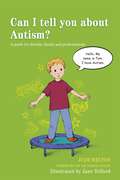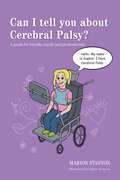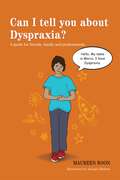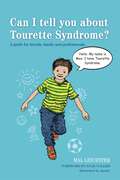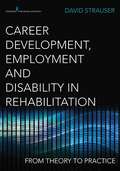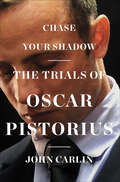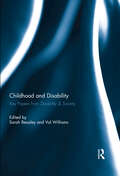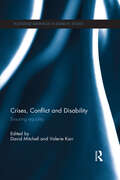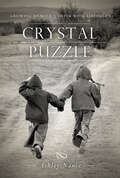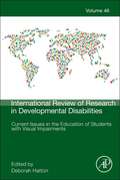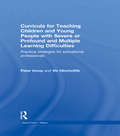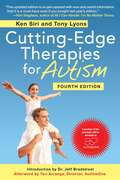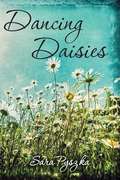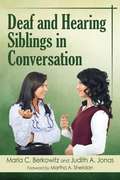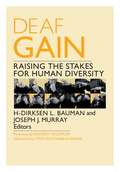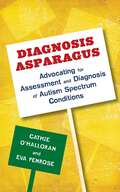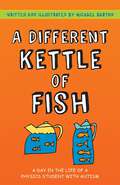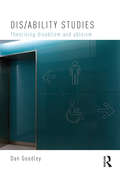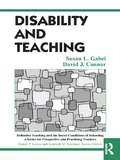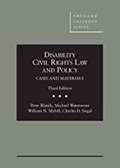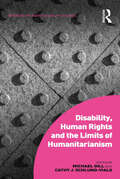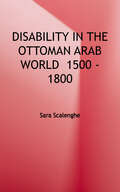- Table View
- List View
Can I tell you about Autism?: A guide for friends, family and professionals
by Jane Telford Jude Welton Glenys JonesMeet Tom - a young boy with autism. Tom invites readers to learn about autism from his perspective, helping them to understand what it is and explaining the challenges he faces with issues such as social communication, sensory overload and changes in his routine. Tom tells readers about all the ways he can be helped and supported by those around him. This illustrated book is ideally suited for readers aged 7 and upwards, and will be an excellent way to increase understanding about autism, in the classroom or at home. It also includes clear, useful information for parents and professionals.
Can I tell you about Cerebral Palsy?: A guide for friends, family and professionals
by Katie Stanton Marion StantonMeet Sophie - a girl with cerebral palsy (CP). Sophie invites readers to learn about CP from her perspective, helping them to understand what it is like to use a wheelchair to move around and assistive technology to communicate. She also introduces readers to some of her friends who have different forms of CP and explains that living with CP can sometimes be difficult, but there are many ways she is supported so that she can lead a full and happy life. This illustrated book is ideal for young people aged 7 upwards, as well as parents, friends, teachers and professionals working with children with CP. It is also an excellent starting point for family and classroom discussions.
Can I tell you about Dyspraxia?: A guide for friends, family and professionals
by Maureen Boon Imogen HallamMeet Marco - a boy with dyspraxia, which is sometimes called Developmental Co-ordination Disorder (DCD). Marco invites readers to learn about dyspraxia from his perspective, helping them to understand what it is and what it feels like when he sometimes struggles to control his movement and co-ordination. He talks about the challenges of having dyspraxia and lets readers know how he can be helped and supported. This illustrated book will be an ideal introduction for young people, aged 7 upwards, as well as parents, friends, teachers and professionals working with children with dyspraxia. It is also an excellent starting point for family and classroom discussions.
Can I tell you about Tourette Syndrome?: A guide for friends, family and professionals
by Julie Collier Apsley Mal LeicesterMeet Max - a boy with Tourette syndrome (TS). Max invites readers to learn about Tourette's from his perspective, helping them to understand what tics and triggers are and what it feels like to have TS. He explains how living with TS can sometimes be difficult, and how people around him can help him to feel happy and accepted. This illustrated book is ideal for young people aged 7 upwards, as well as parents, friends, teachers and other professionals working with children with TS. It is also an excellent starting point for family and classroom discussions.
Career Development, Employment, and Disability in Rehabilitation: From Theory to Practice
by David Strauser<p>This text provides, from a rehabilitation perspective, comprehensive coverage of the dominant theories and techniques related to the occupational development, vocational behavior, and the organizational factors that impact the career development and employment of individuals with disabilities. It is designed for the CORE-mandated required course on employment and career development for the Master's Degree in rehabilitation counseling and for Licensed Professional Counselor certification. As the only book in rehabilitation and counseling that broadly addresses career development and employment of individuals with disabilities, it is a major contribution to the literature. <p>Topics covered include major constructs in career development and employment of disabled individuals, theoretical foundations, occupational assessment, information and evaluation, intervention strategies, and populations and settings. To facilitate learning and promote application of theories and techniques, each chapter includes chapter objectives, discussion and review questions, and case studies. An instructor's manual is also included.</p>
Chase Your Shadow: The Trials of Oscar Pistorius
by John CarlinOscar Pistorius was eleven months old when he had both legs amputated below the knee, due to congenital fibular disease. Despite this severe disability, Pistorious grew up to be an extraordinary athlete, inspirational role model, and global symbol of resilience. In 2012 he became the first amputee runner in history to compete in the Olympics and was hailed as a hero not only in his native South Africa but around the world.Everything changed for Pistorius in the early morning hours of February 14, 2013—Valentine's Day—when he shot and killed his girlfriend, model Reeva Steenkamp, through a closed bathroom door, allegedly because he mistook her for an intruder intent on doing him harm. He was arrested and charged with premeditated murder, and overnight, the public's view of Pistorius turned on its head.Not since the O. J. Simpson case has a courtroom drama riveted global attention on one man's fate. Acclaimed journalist John Carlin's vivid firsthand account of Pistorius's seven-month murder trial, broadcast worldwide from Johannesburg, details the wrenching emotional breakdowns and merciless interrogation of the accused on and off the stand, the fraught relationship between the Pistorius and Steenkamp families, and the highly controversial verdict of culpable homicide, for which Pistorius received a five-year sentence.But Chase Your Shadow is far more than just a sensational crime story, as Carlin shows through meticulous reporting and extensive access to Pistorius and his family and friends. This courtroom confrontation between a white, privileged, twenty-seven-year-old male athlete on trial for murder and the black female judge who alone would decide his fate—held in a democratic country trying to exorcise its history of racial hatred and endemic violence against women—exposes the complex social and political realities of post-Apartheid South Africa.
Childhood and Disability: Key papers from Disability & Society
by Sarah BeazleyDrawn from Disability & Society over the period 1997-2012, the twelve chapters in this book address a range of personal, cultural and institutional arenas in which challenges experienced by disabled children are played out. The book includes a mix of theoretical and applied material offering both powerful conceptual tools and practical insights, enabling readers to connect the work of recent decades to their own research and questions about disability and childhood. Readers will find this book an invaluable resource for understanding what we have learned about disability and childhood through the pages of the world leading international journal in the field. The collection makes available a well-informed understanding of conditions, policies and practices that create disability in children's lives so that we can further the struggle for a more inclusive future in which inequalities structured around impairment are removed. The importance of children’s own voices for resisting disablement in childhood is clearly foregrounded in this invaluable collection.This book was originally published as a special issue of Disability & Society.
Crises, Conflict and Disability: Ensuring Equality (Routledge Advances in Disability Studies)
by David Mitchell Valerie KarrPeople with disabilities are among the most adversely affected during conflict situations or when natural disasters strike. They experience higher mortality rates, have fewer available resources and less access to help, especially in refugee camps, as well as in post-disaster environments. Already subject to severe discrimination in many societies, people with disabilities are often overlooked during emergency evacuation, relief, recovery and rebuilding efforts. Countries party to the UN Convention on the Rights of Persons with Disabilities must take all necessary measures to ensure the protection and safety of people with disabilities during situations of armed conflict, humanitarian emergencies, and natural disasters. Such aid should be designed to support preparedness, response, recovery and rebuilding. This book includes perspectives from around the globe and explores the implications at the policy, programme, and personal level, discussing issues such as: How can national laws, policies, and regulations provide guidance, methods and strategies to integrate and coordinate inclusive emergency management? What should people with disabilities know in order to be prepared for emergency situations? What lessons have we learned from past experiences? What are the current shortfalls (physical and cultural) that put people with disabilities at risk during emergencies and what can be done to improve these situations (e.g. through new technologies and disaster planning)? How does disability affect people’s experiences as refugees and other displaced situations; what programmes and best practices are in place to protect and promote their rights during their period of displacement? How must disabled people with disabilities be factored in to the resettlement and rebuilding process; does an opportunity for ensuring universal access exist in the rebuilding process? What is the impact of disasters and conflicts on such special populations as disabled women, disabled children, and those with intellectual disabilities? Spotlighting a pressing issue that has long been neglected in emergency planning fields, this innovative book discusses how to meet the needs of people with disabilities in crises and conflict situations. It is an important reference for all those working in or researching disability and inclusion, and emergency and disaster management, both in developed and developing countries.
Crystal Puzzle: Growing Up with a Sister with Asperger's
by Ashley NanceA delightful and true story of growing up with a sister with Asperger's Syndrome, The Crystal Puzzle chronicles powerful family experiences from the realization that there was something different about her sister through the hopes and joys and challenges of school to the eventual independence that comes with growing apart as one sister moves on and out of the home. Blogger Ashley Nance offers an accurate, humorous, touching, and poignant glimpse into the lives of those affected by Asperger's and learning disabilities.Crystal Puzzle also includes a helpful resource section for families interested in additional information to help them cope and succeed given the challenges that come with Asperger's and other learning disabilities.
Current Issues in the Education of Students with Visual Impairments (International Review of Research in Developmental Disabilities, Volume #46)
by Deborah D. HattonThis edition addresses current issues in the education of students with visual impairments and includes the expanded core curriculum for students with visual impairment, assistive technology, Braille reading comprehension, communication development, orientation and mobility issues, and more.
Curricula for Teaching Children and Young People with Severe or Profound and Multiple Learning Difficulties: Practical strategies for educational professionals (nasen spotlight)
by Peter Imray Viv HinchcliffeCurricula for Teaching Children and Young People with Severe or Profound and Multiple Learning Difficulties offers a range of compelling arguments for a distinct and separate pedagogical approach to the learning needs of the most educationally challenging pupils. This book, written in accessible, common sense and non-academic language, provides an easy-to-follow alternative curriculum specifically designed to enhance and enrich the learning of children with profound and multiple learning difficulties. Chapter by chapter, guidelines and support are offered in key curriculum areas, some of which include: Cognition Language, Literacy and Communication Mathematical Physical Sensory Creative Care Play Problem solving. This highly practical resource is essential reading for any educational professional, parents, school governors, teachers, teaching assistants, therapists and indeed anyone involved with maximising the educational opportunities of those with profound learning difficulties.
Cutting-Edge Therapies for Autism, Fourth Edition
by Tony Lyons Teri Arranga Ken SiriThe parents of children with autism know that learning about treatments is a full-time job. For parents with limited time, ability, or resources, Ken Siri and Tony Lyons have compiled the latest in autism research and treatment. Exploring the possible causes of autism and presenting novel therapies, medications, and interventions, Cutting-Edge Therapies for Autism contains contributions from more than ninety experts on a wide variety of research findings, therapies, models, and multifaceted evaluation and treatment centers.Revised and fully updated to include the latest developments, this fourth edition includes up-to-date information on mitochondrial, antifungal, and physical therapy treatments; about speech, art, music, and sound therapies; and how diets, HANDLE, indigenous healing, and other exciting new treatments can be used to help your child. It also addresses developing technologies, like the iPad, which provides hundreds of apps that help kids with autism communicate and organize their day, and helps parents keep track of therapy schedules. Filled with case studies and research, Cutting-Edge Therapies for Autism is a detailed and informative guide for anyone affected by autism.
Dancing Daisies
by Sara PyszkaBrynn has cerebral palsy and her relationship with her two best friends is just shattered. Brynn is looking forward more than ever to her summer at Camp Lakewood.
Deaf And Hearing Siblings In Conversation
by Marla C. Berkowitz Judith A. JonasThis is the first book to consider both deaf and hearing perspectives on the dynamics of adult sibling relationships. Deaf and hearing authors Berkowitz and Jonas conducted interviews with 22 adult siblings, using ASL and spoken English, to access their intimate thoughts. A major feature of the book is its analysis of how isolation impacts deaf-hearing sibling relationships. The book documents the 150 year history of societal attitudes embedded in sibling bonds and identifies how the siblings' lives were affected by the communication choices their parents made. The authors weave information throughout the text to reveal attitudes toward American Sign Language and the various roles deaf and hearing siblings take on as monitors, facilitators, signing-siblings and sibling-interpreters, all of which impact lifelong bonds. Included: questions for guided discussion, extensive bibliography, and other features.
Deaf Gain
by Joseph J. Murray H-Dirksen L. BaumanDeaf people are usually regarded by the hearing world as having a lack, as missing a sense. Yet a definition of deaf people based on hearing loss obscures a wealth of ways in which societies have benefited from the significant contributions of deaf people. In this bold intervention into ongoing debates about disability and what it means to be human, experts from a variety of disciplines--neuroscience, linguistics, bioethics, history, cultural studies, education, public policy, art, and architecture--advance the concept of Deaf Gain and challenge assumptions about what is normal.Through their in-depth articulation of Deaf Gain, the editors and authors of this pathbreaking volume approach deafness as a distinct way of being in the world, one which opens up perceptions, perspectives, and insights that are less common to the majority of hearing persons. For example, deaf individuals tend to have unique capabilities in spatial and facial recognition, peripheral processing, and the detection of images. And users of sign language, which neuroscientists have shown to be biologically equivalent to speech, contribute toward a robust range of creative expression and understanding. By framing deafness in terms of its intellectual, creative, and cultural benefits, Deaf Gain recognizes physical and cognitive difference as a vital aspect of human diversity.Contributors: David Armstrong; Benjamin Bahan, Gallaudet U; Hansel Bauman, Gallaudet U; John D. Bonvillian, U of Virginia; Alison Bryan; Teresa Blankmeyer Burke, Gallaudet U; Cindee Calton; Debra Cole; Matthew Dye, U of Illinois at Urbana-Champaign; Steve Emery; Ofelia García, CUNY; Peter C. Hauser, Rochester Institute of Technology; Geo Kartheiser; Caroline Kobek Pezzarossi; Christopher Krentz, U of Virginia; Annelies Kusters; Irene W. Leigh, Gallaudet U; Elizabeth M. Lockwood, U of Arizona; Summer Loeffler; Mara Lúcia Massuti, Instituto Federal de Santa Catarina, Brazil; Donna A. Morere, Gallaudet U; Kati Morton; Ronice Müller de Quadros, U Federal de Santa Catarina, Brazil; Donna Jo Napoli, Swarthmore College; Jennifer Nelson, Gallaudet U; Laura-Ann Petitto, Gallaudet U; Suvi Pylvänen, Kymenlaakso U of Applied Sciences; Antti Raike, Aalto U; Päivi Rainò, U of Applied Sciences Humak; Katherine D. Rogers; Clara Sherley-Appel; Kristin Snoddon, U of Alberta; Karin Strobel, U Federal de Santa Catarina, Brazil; Hilary Sutherland; Rachel Sutton-Spence, U of Bristol, England; James Tabery, U of Utah; Jennifer Grinder Witteborg; Mark Zaurov.
Diagnosis and treatment of blind and visually impaired
by Dolly SinghThis publication provides readers with an understanding of visual impairment and blindness, particularly the cortical visual impairment. An overview of eye diseases, low vision, vision loss, and blindness is given. Uses of assistive technology, remote infrared audible signage and GPS for visually impaired are described.
Diagnosis Asparagus: Advocating for Assessment and Diagnosis of Autism Spectrum Conditions
by Eva Penrose Catherine O'HalloranA highly readable, insightful and sometimes humorous account of autism assessment, diagnosis and life with a 'label'. Eva was diagnosed with Asperger Syndrome (ASD) at age 11 and is now a fun-loving, sociable 16-year-old. This book, co-written with her mother, a speech and language therapist, discusses their reasons for seeking a diagnosis, the process of being assessed, their reactions to the news and the impact it has had on Eva's life. It also considers how diagnosis has helped them find strategies to lessen the challenges of living with an ASD. Concluding that it doesn't really matter whether the name for the set of traits that characterise autism changes or what it changes to, this life-affirming book shows diagnosis to be a positive and empowering experience. It will be helpful to any family embarking on the assessment process as well as professionals looking for insight into a family's diagnosis journey.
A Different Kettle of Fish: A Day in the Life of a Physics Student with Autism
by Michael Barton Delia Barton"I'm looking at the Solar System display when I hear a child close by shouting at his mum, to which she replies 'No need to bite my head off!' I've heard of laughing your head off (to laugh a lot) and even biting your tongue (to be quiet) but biting someone's head off puts a rather more vivid picture into my mind!" During a trip to London, taking in tube announcements, guitar shops, and the Science Museum Michael Barton explores and explains the confusing "neurotypical" world of contradictory signage, hidden meanings and nonsensical figures of speech. His quirky and comic illustrations bring to life the journey from the comfort of his familiar university surroundings into the hectic bustle of central London. A fun and enlightening read for friends, family, caring professionals and anyone interested in an alternative viewpoint on the world. Sure to "strike a chord" with other day trippers on the autism spectrum.
Dis/ability Studies: Theorising disablism and ableism
by Dan GoodleyIn this ground-breaking new work, Dan Goodley makes the case for a novel, distinct, intellectual, and political project – dis/ability studies – an orientation that might encourage us to think again about the phenomena of disability and ability. Drawing on a range of interdisciplinary areas, including sociology, psychology, education, policy and cultural studies, this much needed text takes the most topical and important issues in critical disability theory, and pushes them into new theoretical territory. Goodley argues that we are entering a time of dis/ability studies, when both categories of disability and ability require expanding upon as a response to the global politics of neoliberal capitalism. Divided into two parts, the first section traces the dual processes of ableism and disablism, suggesting that one cannot exist without the other, and makes the case for a research-driven and intersectional analysis of dis/ability. The second section applies this new analytical framework to a range of critical topics, including: The biopolitics of dis/ability and debility Inclusive education Psychopathology Markets, communities and civil society. Dis/ability Studies provides much needed depth, texture and analysis in this emerging discipline. This accessible text will appeal to students and researchers of disability across a range of disciplines, as well as disability activists, policymakers, and practitioners working directly with disabled people.
Disability and Special Needs
by Dolly SinghThis publication titled "Disability and Special Needs: Dimensions and Perspectives", provides readers with an understanding of disability in a wider perspective, including details about dimensions; key facts; global classification; etc.
Disability and Teaching (Reflective Teaching and the Social Conditions of Schooling Series)
by David Connor Susan GabelDisability and Teaching highlights issues of disability in K-12 schooling faced by teachers, whoare increasingly accountable for the achievement of all students regardless of the labelsassigned to them. It is designed to engage prospective and practicing teachers in examining theirpersonal theories and beliefs about disability and education. Part I offers four case studies dealing with issues such as inclusion, over-representation inspecial education, teacher assumptions and biases, and the struggles of novice teachers. Thesecases illustrate the need to understand disability and teaching within the contexts of school,community, and the broader society and in relation to other contemporary issues facing teachers.Each is followed by space for readers to write their own reactions and reflections, educators’dialogue about the case, space for readers’ reactions to the educators’ dialogue, a summary, andadditional questions. Part II presents public arguments representing different views about thetopic: conservative, liberal-progressive, and disability centered. Part III situates the authors’personal views within the growing field of Disability Studies in education and provides exercisesfor further reflection and a list of resources. Disability and Teaching is the 8th volume in the Reflective Teaching and the Social Conditions ofSchooling Series, edited by Daniel P. Liston and Kenneth M. Zeichner. This series of small,accessible, interactive texts introduces the notion of teacher reflection and develops it in relationto the social conditions of schooling. Each text focuses on a specific issue or content area inrelation to teaching and follows the same format. Books in this series are appropriate for teachereducation courses across the curriculum.
Disability and the Good Human Life
by Jerome E. Bickenbach Franziska Felder Barbara Schmitz Jerome E. Bickenbach Franziska FelderThis collection of original essays, from both established scholars and newcomers, takes up a recent debate in philosophy, sociology, and disability studies on whether disability is intrinsically a harm that lowers a person's quality of life. While this is a new question in disability scholarship, it also touches on one of the oldest philosophical questions: what is the good human life? Historically, philosophers have not been interested in the topic of disability, and when they are it is usually only in relation to questions such as euthanasia, abortion, or the moral status of disabled people. Consequently disability has been either ignored by moral and political philosophers or simply equated with a bad human life, a life not worth living. This collection takes up the challenge that disability poses to basic questions of political philosophy and bioethics, among others, by focusing on fundamental issues and practical implications of the relationship between disability and the good human life.
Disability Civil Rights Law And Policy, Cases And Materials (American Casebook)
by Peter Blanck Michael Waterstone William N. Myhill Charles D. SiegalThis casebook examines the development of disability rights law and policy in the United States and abroad and can be used as either a law or graduate school teaching tool. It gives a complete and current treatment of the Americans with Disabilities Act and the ADA Amendments Act, including the background of the statute's passage, definition of disability, discrimination in employment, public services, and public accommodations. It also gives in-depth coverage of other important federal disability discrimination statutes like the Individuals with Disabilities Education Act, Rehabilitation Act, and Fair Housing Amendments Act. This book is unique in that it offers extensive coverage of the rapidly developing area of international disability law, through discussion of the new UN Convention on Rights of Persons with Disabilities and related developments. The authors also offer detailed coverage of current policy issues involving taxation, health policy, and technology. The book has been streamlined significantly since the last edition.
Disability, Human Rights and the Limits of Humanitarianism (Interdisciplinary Disability Studies)
by Michael Gill Cathy J. Schlund-VialsDisability studies scholars and activists have long criticized and critiqued so-termed ’charitable’ approaches to disability where the capitalization of individual disabled bodies to invoke pity are historically, socially, and politically circumscribed by paternalism. Disabled individuals have long advocated for civil and human rights in various locations throughout the globe, yet contemporary human rights discourses problematically co-opt disabled bodies as ’evidence’ of harms done under capitalism, war, and other forms of conflict, while humanitarian non-governmental organizations often use disabled bodies to generate resources for their humanitarian projects. It is the connection between civil rights and human rights, and this concomitant relationship between national and global, which foregrounds this groundbreaking book’s contention that disability studies productively challenge such human rights paradigms, which troublingly eschew disability rights in favor of exclusionary humanitarianism. It relocates disability from the margins to the center of academic and activist debates over the vexed relationship between human rights and humanitarianism. These considerations thus productively destabilize able-bodied assumptions that undergird definitions of personhood in civil rights and human rights by highlighting intersections between disability, race, gender ethnicity, and sexuality as a way to interrogate the possibilities (and limitations) of human rights as a politicized regime.
Disability in the Ottoman Arab World, 1500-1800 (Cambridge Studies in Islamic Civilization Ser.)
by Sara ScalenghePhysical, sensory, and mental impairments can influence an individual's status in society as much as the more familiar categories of gender, class, religion, race, and ethnicity. This was especially true of the early modern Arab Ottoman world, where being judged able or disabled impacted every aspect of a person's life, including performance of religious ritual, marriage, job opportunities, and the ability to buy and sell property. Sara Scalenghe's book is the first on the history of both physical and mental disabilities in the Middle East and North Africa, and the first to examine disability in the non-Western world before the nineteenth century. Unlike previous scholarly works that examine disability as discussed in religious texts such as the Qur'an and the Hadith, this study focuses on representations and classifications of disability and impairment across a wide range of biographical, legal, medical, and divinatory primary sources.
